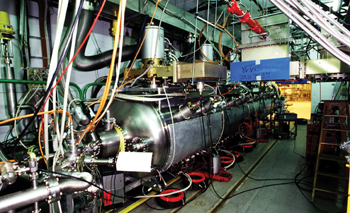Superconducting technology is becoming the standard
route for supplying
power to high-energy particle beams. The latest
specialist workshop, which was held in Japan, provided
a valuable window on progress.

Radiofrequency (RF) electric fields provide the motive power for high-energy accelerators. In the continuing bid for higher energies, superconducting techniques are increasingly being used to obtain maximum electronvolts from the wall plug.
The traditional biennial meeting of experts in RF superconductivity reflects the continual and impressive progress being made. The tenth workshop was jointly organized by the Japanese KEK and JAERI laboratories and held in Tsukuba on 6-11 September under the chairmanship of Shuichi Noguchi.
The first day’s sessions were devoted to laboratory review talks in the traditional alphabetic order. First to deliver was Argonne National Laboratory, where R&D to design and finalize accelerating structures for the Rare Isotope Accelerator (RAI) is gaining momentum. The last of the reviews was from Wuppertal University, where high critical-temperature materials are being examined both for their RF properties and for possible applications, such as in superconducting RF filters.
Evidently, all laboratories in the TESLA collaboration for a superconducting linear electron-positron collider had put in a major effort to finalize the technical details for their machine proposal with its incorporated X-ray Free Electron Laser presented earlier this year (CERN Courier June p20). The very ambitious goal of $2000 per superconducting MV, pronounced long ago by the late Bjorn Wiik, who was one of the driving forces for TESLA, has nearly been achieved. Reliable but inexpensive fabrication, final surface treatment and assembly techniques are essential for building the required 20,000 cavities. Manufacturing by hydroforming or by spinning several cells from one tube were reviewed extensively. For surface treatment, electropolishing and high-pressure water rinsing are now standard.
Similar techniques will be applied for the improved cavities for the upgrade of the Jefferson Laboratory’s CEBAF machine to 12 GeV. CERN’s effort to produce the LHC 400 MHz superconducting modules in niobium copper technology was covered. CERN also collaborates with several laboratories using its existing facilities from the increased energy effort at LEP2. These remain operational for the preparation and future maintenance of cavities for CERN’s future LHC collider.
Proton machines
Another effort is focused on high-current superconducting proton (or light ion) linacs. Beam energies (per nucleon) will largely exceed those reliably delivered for many years by ATLAS (Argonne) or ALPI (INFN Legnaro), coming close to or even exceeding 1 GeV. This covers a large number of projects or studies: the Spallation Neutron Source (SNS) under construction at Oak Ridge, for which the Jefferson Laboratory is in charge of cavity production in close collaboration with Los Alamos; the “joint project” of JAERI and KEK; the European Spallation Source; the French 700 MHz proton linac; the Advanced Accelerator Applications project at Los Alamos; the Italian TRASCO; and CERN’s SPL.
These proton linacs and the RAI at Argonne now unify the superconducting RF community, which has been split until now into “low beta” (below say ß = 0.2, where ß is the ratio between the beam particle velocity and that of light) and “high beta” (practically ß = 1) applications, with nothing in between. To study fully superconducting options for these machines, the length of the typically “elliptical” ß = 1 cavities – such as those used for LEP2 – is squeezed down to about ß = 0.5, where mechanical stability problems start to arise.
At the other end of the range the typical low-ß spoke resonators or H-mode structures are being “stretched” to about the same ß, hence supplying superconducting resonators suitable for all ß. This includes even a very-low energy superconducting radiofrequency quadrupole under development at INFN-Legnaro in Italy.








